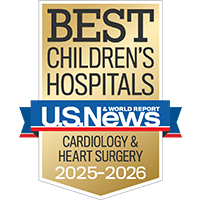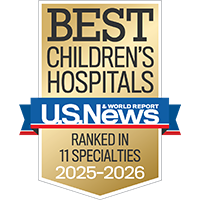Soothing the soul
Our music therapy program nurtures patients with bedside serenades, rap workshops and more.
Find out more

In hypoplastic left heart syndrome, the left side of the heart — the part that pumps oxygenated blood to the rest of the body — is underdeveloped. Its two chambers, called the left atrium and the left ventricle, and their valves may be tiny, blocking the flow of oxygenated blood from the lungs.
The heart consists of four chambers: the two upper chambers, called atria, where blood enters the heart, and the two lower chambers, called ventricles, where blood is pumped out of the heart. The flow between the chambers is controlled by a set of valves that act as one-way doors. Normally blood is pumped from the right side of the heart through the pulmonary valve and the pulmonary artery to the lungs, where the blood is filled with oxygen. From the lungs, the blood travels back down to the left atrium and left ventricle. The newly oxygenated blood then is pumped through another big blood vessel called the aorta to the rest of the body.
Babies with hypoplastic left heart syndrome may seem healthy at birth because the patent ductus arteriosus (PDA) is still open. The PDA is a blood vessel that connects the pulmonary artery to the aorta, allowing blood to continue circulating directly into the aorta and out to the rest of the body, bypassing the lungs and the defective left side of the heart. Once the PDA closes a few days after birth, blood flows to the lungs and then to the left side of the heart, where it is blocked and can't circulate through the rest of the body.
Without treatment, babies afflicted with hypoplastic left heart syndrome can die within the first days or weeks of life. Treatment consists of a heart transplant or a series of operations to restore the function of the left side of the heart. Intravenous medication can keep the PDA open until surgery can be performed, but is not a permanent treatment.
Babies born with hypoplastic left heart syndrome may seem normal at birth but become severely ill soon after birth. Babies may appear ashen or gray, have rapid and difficult breathing and have difficulty feeding. This heart defect is usually fatal within the first days or month of life unless treated.
Symptoms include:
Babies with this disorder could go into shock if the blood flow between the right and left sides of the heart is blocked because of the congenital defect. Signs of shock are abnormal breathing, dialated pupils and a weak and rapid pulse.
A diagnosis of hypoplastic left heart syndrome is confirmed with an echocardiogram, a test that uses sound waves to create a moving picture of the heart.
Treatment for hypoplastic left heart syndrome requires either a three-step surgical procedure called staged palliation or a heart transplant.
Staged palliation is considered one of the major achievements of congenital heart surgery in recent years. The survival rate for children at age 5 is about 70 percent and most of these children have normal growth and development. This three-step surgery procedure is designed to create normal blood flow in and out of the heart, allowing the body to receive the oxygenated blood it needs.
The three steps consist of the following procedures:
Heart transplant is another option for infants with hypoplastic left heart syndrome. However, suitable donor hearts for babies are often in short supply.
Hypoplastic left heart syndrome sufferers will require life-long cardiac care as well as medication. They also will be more prone to heart valve infections, called endocarditis, and will need to take antibiotics before surgery or dental treatment.
UCSF Benioff Children's Hospitals medical specialists have reviewed this information. It is for educational purposes only and is not intended to replace the advice of your child's doctor or other health care provider. We encourage you to discuss any questions or concerns you may have with your child's provider.
 19
19
 2
2


Best in Northern California for cardiology & heart surgery

Ranked among the nation's best in 11 specialties
Soothing the soul
